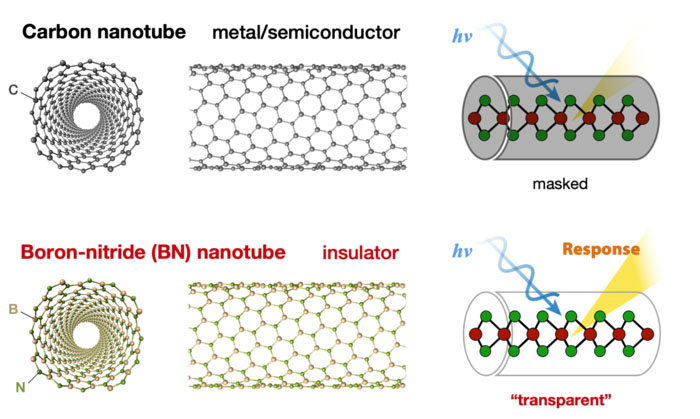Boron Nitride Nanotubes: Properties, Synthesis, and Applications
What are Boron Nitride Nanotubes?
Boron nitride nanotubes (BNNTs) are a type of one-dimensional nanostructure composed of boron and nitrogen atoms arranged in a tubular form. They are structurally similar to carbon nanotubes (CNTs) but possess distinct properties that make them attractive for various applications.

Synthesis of Boron Nitride Nanotubes
Several methods have been developed for the synthesis of BNNTs, including:
- Chemical Vapor Deposition (CVD): Chemical Vapor Deposition method involves the reaction of boron and nitrogen precursors at high temperatures (1000-1500 –C) in the presence of a catalyst. The precursors decompose and form BNNTs on the catalyst surface.
- Laser Ablation: In this technique, a boron nitride target is vaporized using a high-powered laser in a nitrogen atmosphere. The vaporized material condenses and forms BNNTs.
- Ball Milling: This mechanical method involves the high-energy milling of boron and nitrogen precursors in a sealed container. The impact and shear forces during milling lead to the formation of BNNTs.
Properties of Boron Nitride Nanotubes
BNNTs exhibit several unique properties that distinguish them from CNTs and make them attractive for various applications:
- Wide Band Gap: BNNTs have a wide band gap of approximately 5-6 eV, making them electrically insulating. This property is advantageous for dielectric and high-temperature applications.
- High Thermal Conductivity: BNNTs possess excellent thermal conductivity, surpassing that of CNTs. This property makes them promising for thermal management applications.
- Chemical and Thermal Stability: BNNTs are highly stable under harsh chemical environments and high temperatures. They are resistant to oxidation and maintain their structural integrity up to 800 –C in air.
- Mechanical Strength: BNNTs exhibit high mechanical strength and stiffness, comparable to CNTs. They have a high Young's modulus and tensile strength, making them suitable for reinforcement applications.
Applications of Boron Nitride Nanotubes
The unique properties of BNNTs make them promising for a wide range of applications, including:
Composites
BNNTs can be used as reinforcing agents in polymer, ceramic, and metal matrix composites. Their high mechanical strength and thermal conductivity can enhance the mechanical and thermal properties of the composite materials.
Electronics
The insulating nature of BNNTs makes them suitable for dielectric and insulating applications in electronic devices. They can be used as gate dielectrics in field-effect transistors and as insulating layers in high-temperature electronics.
Biomedical Applications
BNNTs have shown potential in biomedical applications due to their biocompatibility and unique properties. They can be used as drug delivery vehicles, biosensors, and scaffolds for tissue engineering.
Hydrogen Storage
BNNTs have been explored as potential materials for hydrogen storage. Their high surface area and unique electronic structure make them promising for adsorbing and storing hydrogen molecules.
Comparison with Carbon Nanotubes
Boron nitride nanotubes (BNNTs) are often compared to carbon nanotubes (CNTs) due to their structural similarity. However, BNNTs possess several distinct properties that make them advantageous for specific applications:
- Electrical Properties: While CNTs can be metallic or semiconducting depending on their chirality, BNNTs are always electrically insulating with a wide band gap. This makes BNNTs more suitable for dielectric and insulating applications in electronics, where CNTs may cause short circuits.
- Thermal Stability: BNNTs exhibit higher thermal stability compared to CNTs. They can withstand temperatures up to 800 –C in air without structural degradation, whereas CNTs start to oxidize at around 400-500 –C. This makes BNNTs more suitable for high-temperature applications.
- Chemical Inertness: BNNTs are more chemically inert than CNTs. They are resistant to oxidation and acid/base treatments, making them suitable for applications in harsh chemical environments.
- Thermal Conductivity: BNNTs have a higher thermal conductivity than CNTs, making them more efficient for thermal management applications, such as in heat sinks and thermal interface materials.
- Biocompatibility: BNNTs have shown better biocompatibility compared to CNTs. They exhibit lower cytotoxicity and better cell viability, making them more suitable for biomedical applications, such as drug delivery and tissue engineering.
Despite these advantages, CNTs still have a broader range of applications due to their well-established synthesis methods, better electrical conductivity, and the ability to be functionalized easily. CNTs are widely used in applications such as conductive composites, energy storage, and sensing.
In summary, while CNTs have a longer history and a wider range of applications, BNNTs offer unique properties that make them advantageous for specific applications, particularly in high-temperature, electrically insulating, and biomedical fields. As research on BNNTs progresses, it is expected that they will find increasing use in applications where their distinct properties can be leveraged effectively.
Challenges and Future Perspectives
Despite the promising properties and applications of BNNTs, several challenges need to be addressed for their widespread use. One of the main challenges is the large-scale synthesis of high-quality BNNTs with controlled chirality and diameter. Current synthesis methods often result in a mixture of BNNTs with different chiralities and diameters, which can affect their properties and performance.
Future research on BNNTs will focus on developing scalable and cost-effective synthesis methods, as well as exploring novel functionalization strategies to tailor their properties for specific applications. The integration of BNNTs with other nanomaterials, such as graphene and transition metal dichalcogenides, will also be investigated to create hybrid nanostructures with synergistic properties.
As the field of BNNTs continues to advance, it is expected that these nanotubes will find increasing applications in various sectors, including electronics, composites, energy storage, and biomedicine. The unique properties of BNNTs make them a promising material for the development of next-generation devices and technologies.
Further Reading
Nano Convergence, Boron nitride nanotubes: synthesis and applications
Journal of Materials Research, Boron nitride nanotubes: A review of recent progress on purification methods and techniques
Journal of Materials Research, Recent advances and perspective on boron nitride nanotubes: From synthesis to applications
